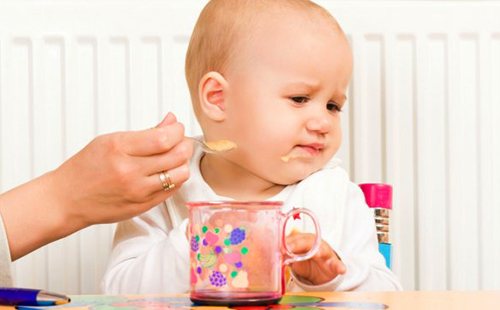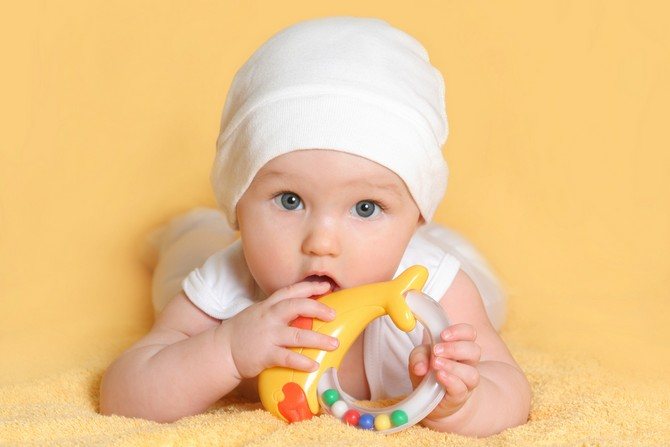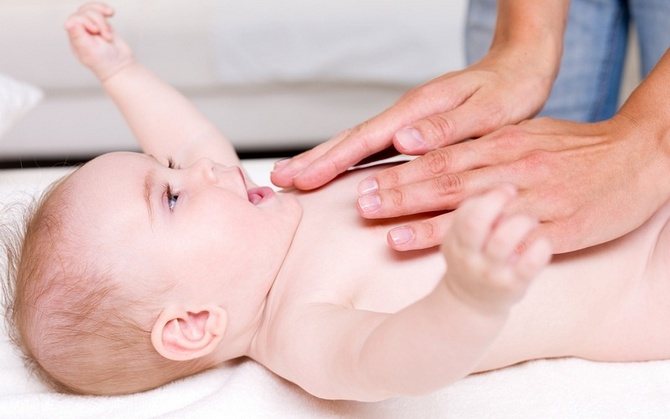Approximate daily routine for a 6 month old baby
- 6:00-8:30 Wake up, morning hygiene, massage and air baths, first meal.
- 8:30-10:00 First sleep period.
- 10:00-13:00 Second feeding immediately after waking up and active wakefulness along with a little exercise and massage treatments.
- 13:00-13:30 Third meal.
- 13:30-15:00 Afternoon rest (best in nature).
- 15:00-17:00 Time for educational games along with gymnastics for kids.
- 17:00-17:30 Fourth feeding.
- 17:30-19:00 A walk in the fresh air, combined with knowledge of the surrounding world and a light sleep.
- 19:00-21:00 Time for family communication and educational games, active leisure and evening swimming.
- 21:00-21:30 Fifth meal.
- 21:30-6:00 Sleep until morning.
There are babies who still wake up for night feedings, so their daily routine will look different.
- 6:00-7:30 Wake up, morning toilet, eat.
- 7:30-9:30 Active leisure, massage, games, getting ready for a walk.
- 9:30-11:00 Walk in the stroller and first nap.
- 11:00-12:00 Lunch meal.
- 12:00-14:30 Afternoon nap time.
- 14:30-15:30 Third feeding.
- 15:30-17:30 Time for gymnastics and educational games.
- 17:30-19:00 Walk in the fresh air, third nap.
- 19:00-19:30 Evening feeding.
- 19:30-21:00 Active leisure, calming games, water treatments.
- 21:00-6:00 Sleep.
- 23:00-2:00 Night meal.
Based on these options for sleep, wakefulness and eating, you can create your own daily routine that will suit your child. After all, each baby is individual, and his daily routine may not coincide with those proposed. Every mother should monitor the condition of her baby in order to correctly determine what he needs now. It is not necessary to strictly follow this regimen minute by minute, you just need to follow their basic principles: the interval between meals should be approximately 4 hours, the baby should be taken out for a walk two or three times, and the child has three periods of sleep during the day.
Hygiene
Hygiene for a six-month-old baby includes washing in the morning, changing a diaper and washing after stool, and bathing before bed.
From birth, a child should be taught the morning procedures of washing, cleaning the mouth, and cleaning the ears. Every morning in the family should begin with these mandatory rituals, because they are the key to health. Even if the baby does not yet have teeth, this does not mean that his mouth does not need to be cleaned. Prevention of caries, stomatitis and infantile thrush has not been canceled. For oral hygiene, there are special wipes impregnated with a cleanser based on herbal ingredients. It is recommended to use them after each feeding, and do not forget to wipe the gums and tongue. Well, the first teeth must be brushed using the same solution and fingertips with brushes.
Changing the diaper should also be regular: it should be changed every 2 hours or after each bowel movement. A mandatory procedure after this should be washing with warm water or thoroughly wiping with a baby wipe. The second option is convenient to use outside the home, and the first method is always preferable. When washing, you need to hold the child facing you so that fecal particles do not get on the genitals and cause inflammation. After washing, it will be very useful to leave the baby naked for a while - this is a good way to harden and prevent diaper rash.
A six-month-old baby is already sitting perfectly, so bathing before bed will be fun if you take bath toys with you. Children of this age love to splash in the water, so you can devote more time to this activity, for example, start drawing a bath an hour before bedtime. It is no longer necessary to bathe your child with a herbal decoction; you can make a bubble bath by adding baby shampoo to the water. The water temperature remains unchanged - 37 degrees.
Dream

A 6-month-old baby on average needs 15 hours of sleep per day. Of these hours, 10 are allocated for night sleep, and 5 for daytime sleep. A five-hour daytime nap can be divided into 2 periods of 2.5 hours or 3 periods of 1.5-2 hours. This regime is also purely individual, because children are different. There are active babies who sleep only twice a day, mostly in a stroller in the fresh air, and there are sleepyheads who can sleep three times and for a long time.
The sleep schedule is also a guideline; the baby does not have to strictly follow it. You should not force your child to sleep if he is cheerful, cheerful and active. Moreover, there is no need to constantly use “methods for falling asleep” in the form of pacifiers, motion sickness, etc. When the baby falls asleep on his own, this is a sign of a healthy nervous system, so parents should gradually teach him to sleep in his crib without any additional encouragement to sleep.
Healthy family
A common situation in modern families is when everyone at home revolves around the smallest child. However, this situation often leads to quarrels and conflicts, due to the fact that everyone must neglect their own interests.

Children, first of all, should grow up in happy families - this is the key to their health.
When creating comfort for a child, you should not take it to the point of absurdity and allow a 6-month-old baby to rule everyone. Cub 6 months old. can and should get used to the idea that mom and dad have certain responsibilities, so they need some time to complete them.
Feeding
For the first six months of his life, the baby fully had enough of the nutrients he received through breast milk. Now the time has come when the introduction of complementary feeding is mandatory for all infants, because mother's milk can no longer provide adequate nutrition for the child. However, this does not mean at all that it is time to wean off the breast, quite the opposite: any pediatrician will advise you to continue breastfeeding further. It’s just time to introduce the first complementary foods into the daily diet in the form of juices, one-component purees of vegetables and fruits. Children who were on formula milk began to eat these products already at 4 months.
Complementary feeding table by month (6-9 months)
Each complementary food product should be given to the baby drop by drop, half a teaspoon somewhere in the middle of the day to notice his body’s reaction to the new food. If the child feels well, his skin is clean, and his stool has not changed, then every day you can increase the amount of the product administered. Gradually, the baby’s diet should become such that one of the breastfeedings will be completely replaced by complementary foods. Typically, complementary feeding starts with apple juice and pureed broccoli, cauliflower, pumpkin, zucchini or apples.
After the first purees and juices become familiar food for the child, you can give him dairy-free cereals and the yolk of a hard-boiled egg to try. It can be dissolved in a small amount of breast milk or water.
Approximate diet for a six month old baby
- 6:30 Attachment to the breast.
- 10:00 100 ml of vegetable puree with egg yolk in milk.
- 13:00 Fruit puree 50 ml, breast milk.
- 17:00 200 ml of dairy-free monograin porridge and 50 ml of juice (apple or carrot).
- 21:00 Attachment to the breast.
The nutrition of bottle-fed babies can be the same, only breast milk should be replaced with 250 ml of dry milk formula.
Many mothers wonder how to determine whether the baby has enough nutrition? The answer can be obtained by monitoring the child’s behavior during the period between feedings. If the baby is calm, cheerful, and not capricious, then the nutrition he received during the previous feeding is quite enough for him. A well-fed and healthy baby also gains normal weight.
Often six-month-old babies wake up for night feedings. This is quite normal. The baby will suck some breast milk and fall asleep peacefully. Artificial babies usually sleep all night without waking up, because their diet is richer.
Basic principles
Breast milk provides the full range of needs of the baby's body until the age of six months. This conclusion was made by foreign pediatricians based on a number of studies. The American Academy of Pediatrics notes that breastfeeding eliminates the need to introduce early complementary foods. Children simply do not need additional nutrition.
Artificial nutrition also does not require diet correction. “Modern adapted mixtures include a sufficient amount of nutrients, minerals, and vitamins. Therefore, there is no need to introduce complementary foods earlier,” notes doctor Alena Paretskaya.
Thus, the most important principle for introducing complementary feeding to breastfed, bottle-fed, and mixed-fed babies is that they reach six months of age. Using “adult” products earlier is dangerous by disrupting the digestive system, which is not yet ripe for digesting other foods. And the child does not receive all the nutrients he needs.
International experts also note the following important points.
Complementary feeding does not replace the baby's main food. Breast milk and formula remain the same until one year
Breastfeeding, according to WHO recommendations, is important to continue for up to two years, since breast milk contains valuable components for the maturation of the child’s brain, his nervous system, and the development of immunity.
Complementary feeding is for informational purposes only. Established food standards in grams for children who are breastfed and receiving a high-quality adapted formula are nothing more than a general recommendation, an upper limit
More food than specified in the norms should not be given to avoid overfeeding. Food does not fulfill the function of satiation; breast milk and formula, which are more valuable and nutritious for the child, must cope with it for up to a year. It introduces new tastes, stimulates the functioning of the jaw apparatus, socializes the child and teaches him to eat correctly.
The introduction of products does not tolerate violence. The main question of how to properly introduce complementary foods to a child is the lack of pressure from parents. Food should be of interest to the baby. In an effort to feed him “at all costs,” the mother forms a stable pattern of behavior at the table, in which the child refuses to eat.
Interesting and entertaining are two different things. Feeding with persuasion, with cartoons, and other entertainment has nothing to do with the concept of complementary feeding. The baby must show interest in food himself, and this is only possible if he regularly sits at a common table with adults. Copying the behavior model of adults is a more reliable way to form the right attitude towards food in a child than persuasion and entertainment.
Look at the child, not the deadline. Age of six months is the lower limit of the norm, but it can be adjusted depending on the child’s health status and level of development.
The baby is ready for complementary feeding when he shows interest in food. His ejection reflex has faded and thicker foods than milk and formula do not make him vomit. Consumption of new foods does not cause digestive disorders. The child sits up and can hold a spoon.

General development activities

- Six-month-old babies are interested in touching and holding bright rattles, squeakers, in general, those that also make sounds. It is very important that the mother introduces the baby to new toys, names them and shows how to play with them.
- Although the baby does not speak yet, he is already passively memorizing new words. He develops better and learns about the world around him when he is given objects made of various materials: wood, plastic, fabric, wool. A good boost to the development of fine motor skills occurs when the child feels objects and remembers words that correspond to them: hard, smooth, soft.
- At six months, children's gums itch due to teeth thinning. To help them, there are special teething toys designed to reduce discomfort. The cleanliness of such toys should always be remembered.
- When buying your baby his first rattles, you need to make sure that they are not only bright and beautiful, but also educational. For example, toys with small figures strung on rings or entire rugs with pockets, elastic bands, and cubes can now be found in every toy store.
- There are even special development centers on sale that have many functions for developing a child’s hearing, touch, and motor skills. For a six-month-old baby, such a toy will be timely and will bring a lot of joy.
- Old proven fun games for children such as “Magpie-Crow”, “Ladushki” should not be forgotten either. They belong to the category of finger gymnastics and will not only bring benefits, but will also amuse the baby.
Causes of restless sleep
There are often situations when a child wakes up repeatedly in the middle of the night, which ultimately leads to fatigue and whims. In this case, parents may suspect that the baby is not getting enough sleep or that the child is not getting enough rest. Take a closer look at your baby, consider his routine step by step, consult with your pediatrician and start eliminating the problems. Let's list the main ones.
Teeth cutting
At six months, babies begin to suffer from the eruption of their first teeth. Not everyone is destined to survive this period calmly. Often the baby suffers from pain and discomfort. Rest can also be affected, and at any time of the day. Buy special teething toys, many of which have a cooling effect, and also do not neglect the use of pain-relieving gels. Gum massage helps relieve discomfort.
Introduction of complementary foods
Six months of age is the time to introduce complementary foods. Food that is very different from the usual mother's milk or formula sometimes leads to digestive problems. All trials of new foods should ideally be postponed to the morning so that the baby has the opportunity to calmly digest the new type of food. Before going to bed, feed your baby familiar food.

Sleep disturbance
Sleep can become anxious and restless due to the heat (more details in the article: what to do if your baby sleeps restlessly at night?). A failure can occur both in summer and winter, when the batteries are heated at maximum power. The baby sweats in his sleep, the mucous surface in the nose becomes dry, because of this the child tosses and turns, breathes heavily and poorly. The disorder leads to frequent awakenings. Pediatrician Komarovsky strongly recommends maintaining moist and cool air in the room. The temperature should not be higher than 20˚С. This can be achieved by reducing the battery power and opening the window slightly. You will see for yourself how much calmer your baby’s rest will become.
INTERESTING: newborn has trouble sleeping at night
Violation of the regime
Parents, without meaning to, spoil the quality of their little one’s sleep. Deciding to put him down 1-2 hours later in order to prolong the morning sleep, they end up getting an anxious rest for the baby at night (more details in the article: what should an 8-month-old baby's sleep be like?). The baby often wakes up and gets up in the morning in a bad mood. The nervous system of children at this age is still very fragile - the baby is easily overexcited and has difficulty calming down.
It is extremely important to strictly adhere to the daily routine, to which the child eventually gets used to. Actions performed regularly (eating, walking, bathing, sleeping) help the child feel calm, which means that the rest in this case will be prosperous
READ ALSO: What should be the normal development of a child at seven months?
Night feedings
There are a lot of opinions about night feedings, but most pediatricians, including Dr. Komarovsky, are convinced that there is no need to breastfeed a baby at night after 6 months. A baby asking for a bottle and breast during awakenings is most likely doing this out of habit.
Then it is important to again make sure of the sleeping conditions and check whether the room is cool and fresh. A breastfed baby without feedings can rest peacefully all night without waking up
The natural way of parenting implies the possibility of “providing” the breast to the child at any time and after 6 months, but, as a rule, parents in this case sleep with their children, which means there is no need to get up to the crib. In this matter, each parent is free to choose his own “golden mean”.
READ ALSO: What should a child’s daily routine be like at 6 months?

Big nap
The duration of sleep at night directly depends on the amount of daytime rest. It can be calculated that if we subtract the sleep time during the day from the 14 hours of the daily norm, then the remainder will be the time for night rest. If parents want to give their child a long sleep at night - 9-10 hours, they must regulate the amount of daytime rest, which should not exceed 4 hours
It is important to strictly follow the regime and not be afraid to wake up the baby ahead of time. Everything he didn’t get enough sleep for now, he’ll get at night.
Gymnastic exercises, massage and walks

A grown up active baby learns to control his body every day. He can not only sit, but also tries to get up from a lying position, turns over in all directions, and tries to crawl. Therefore, regular massages and gymnastics are now very important for him to strengthen and develop muscles and stretch joints.
- The best time to exercise is in the morning. The set of exercises should consist of bending and straightening the limbs, sitting down with pull-ups by the handles, lifting with support on both legs, pulling the body by the legs, and getting on all fours.
- After physical activity, it is useful to have a relaxing massage. This is necessary to relieve tension in the muscles and bring pleasure to the baby. The massage may consist of gentle rubbing, stroking, kneading the muscles of the limbs, back and tummy. Before you start performing massage yourself, you should talk to your doctor. He will show you the correct massage techniques and give all the necessary recommendations.
- Before going to bed, immediately after a bath, it is also useful to do a couple of exercises with your child and give him a light massage. After bathing, the baby's joints are steamed, and a few swings, sit-ups and pull-ups will give him great pleasure.
There is nothing more important for small children than walks in the fresh air. They strengthen the immune system, nervous system, improve well-being and mood. In good weather, the baby should be outside for at least 2.5 hours in total. This could be an educational walk in a stroller, sleeping in the fresh air, or being held in the arms of an adult. The mother can send someone close to her for a walk with the child; it will be a joy for both of them. Don't forget about regular ventilation of the children's room.
A certain daily routine is extremely important for a child. It gives him a sense of predictability, thereby having a beneficial effect on the nervous system. A baby who is accustomed to sleeping and eating at a certain time feels calm and protected, and in the future it will be easier for him to get used to kindergarten and school.











